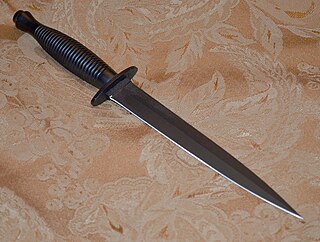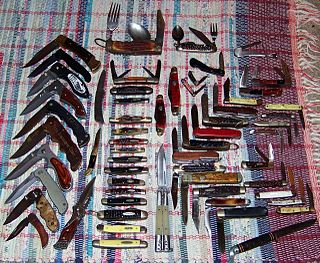
A dagger is a fighting knife with a very sharp point and usually one or two sharp edges, typically designed or capable of being used as a cutting or thrusting weapon. Daggers have been used throughout human history for close combat confrontations, and many cultures have used adorned daggers in ritual and ceremonial contexts. The distinctive shape and historic usage of the dagger have made it iconic and symbolic. A dagger in the modern sense is a weapon designed for close-proximity combat or self-defense; due to its use in historic weapon assemblages, it has associations with assassination and murders. Double-edged knives, however, play different sorts of roles in different social contexts.

A knife is a tool or weapon with a cutting edge or blade, usually attached to a handle or hilt. One of the earliest tools used by humanity, knives appeared at least 2.5 million years ago, as evidenced by the Oldowan tools. Originally made of wood, bone, and stone, over the centuries, in step with improvements in both metallurgy and manufacturing, knife blades have been made from copper, bronze, iron, steel, ceramic, and titanium. Most modern knives have either fixed or folding blades; blade patterns and styles vary by maker and country of origin.

Male dominance, or maledom is a BDSM practice where the dominant partner is male. A sexually dominant male in BDSM practices is also known as a maledom. Maledoms can be professional as well as non-professional. The term ProDom is used for a professional male dominant who earns money by working as a professional dominant as part of the sex industry. A maledom who role-plays a paternal figure is also known as Daddy Dom.

A Bowie knife is a pattern of fixed-blade fighting knife created by Rezin Bowie in the early 19th century for his brother James Bowie, who had become famous for his use of a large knife at a duel known as the Sandbar Fight.
A stiletto is a specialized dagger with a long slender blade and needle-like point, primarily intended as a thrusting and stabbing weapon.

A ballistic knife is a knife with a detachable blade that can be ejected to a distance of several meters/yards by pressing a trigger or operating a lever or switch on the handle. Spring-powered ballistic knives first appeared in books and press reports on Soviet and Eastern Bloc armed forces in the late 1970s. Commercially-produced ballistic knives briefly gained notoriety in the United States in the mid-1980s after they were marketed and sold in the United States and other Western countries. Since then, the marketing and sale of ballistic knives to civilians has been restricted or prohibited by law in several nations.

A trench knife is a combat knife designed to kill or incapacitate an enemy at close quarters, such as in a trench or other confined area. It was developed as a close combat weapon for soldiers attacking enemy trenches during the First World War. An example of a World War I trench knife is the German Army's Nahkampfmesser.

A boot knife or a gambler's dagger is a small fixed-blade knife that is designed to be carried in or on a boot. Typically, such a knife is worn on a belt or under a pant leg. If worn around the neck they become a neck knife. Boot knives generally come with a sheath that includes some form of a clip. Most have double-edged blades, like a dagger, that range from 3 to 5 inches.
Spyderco is an American cutlery company based in Golden, Colorado, producing knives and knife sharpeners. Spyderco pioneered many features that are now common in folding knives, including the pocket clip, serrations, and the opening hole. Spyderco has collaborated with 30 custom knife makers, athletes, and self-defense instructors for designs and innovated the usage of 20 different blade materials.

Survival knives are knives intended for survival purposes in a wilderness environment, often in an emergency when the user has lost most of their main equipment. Most military aviation units issue some kind of survival knife to their pilots in case their aircraft are shot down behind enemy lines and the crew needs tools to facilitate their survival, escape, and rescue. Survival knives can be used for trapping, skinning, wood cutting, wood carving, and other uses. Hunters, hikers, and outdoor sport enthusiasts use survival knives. Some survival knives are heavy-bladed and thick. Other survival knives are lightweight or fold in order to save weight and bulk as part of a larger survival kit. Their functions often include serving as a hunting knife. Features, such as hollow handles, that could be used as storage space for matches or similar small items, began gaining popularity in the 1980s. Custom or semi-custom makers such as Americans Gil Hibben, Jimmy Lile, Bo Randall, and Chris Reeve are often credited with inventing those features.
A combat knife is a fighting knife designed for military use and primarily intended for hand-to-hand or close combat fighting.

The Fairbairn–Sykes fighting knife is a double-edged fighting knife resembling a dagger or poignard with a foil grip. It was developed by William Ewart Fairbairn and Eric Anthony Sykes in Shanghai based on ideas that the two men had while serving on the Shanghai Municipal Police in China before World War II.
Robert Waldorf Loveless, a.k.a. Bob Loveless or RW Loveless, was an American knife maker who designed and popularized the hollowground drop point blade and the use of full tapered tangs and screw-type handle scale fasteners within the art of knifemaking. He is cited by other knifemakers and collectors as one of the most innovative custom knife makers in the world.

A tomato knife is a small serrated kitchen knife designed to slice through tomatoes. The serrated edge allows the knife to penetrate the tomatoes’ skin quickly and with a minimum of pressure without crushing the flesh. Many tomato knives have forked tips that allow the user to lift and move the tomato slices after they have been cut.

A cheese knife is a type of kitchen knife specialized for the cutting of cheese. Different cheeses require different knives, according primarily to hardness. There are also a number of other kitchen tools designed for cutting or slicing cheese, especially the harder types. These include the cheese cutter, cheese slicer, cheese plane, cheese scoop for soft cheese and others, collectively known as cheese servers.
Mad Dog Knives is a custom knifemaking facility headed by Kevin McClung, a former Senior Materials Scientist at the American Rocket Company, Mad Dog Knives is based in Prescott, Arizona. Mad Dog Knives made the fixed-blade knife known as the ATAK, used by Naval Special Warfare Groups 1 and 2 after the "SEAL Trials" of 1992. Mad Dog Knives are typically made from selectively tempered, hand ground O1 Tool Steel with a hardchrome plating to protect the blade.

Knife collecting is a hobby which includes seeking, locating, acquiring, organizing, cataloging, displaying, storing, and maintaining knives. Some collectors are generalists, accumulating an assortment of different knives. Others focus on a specialized area of interest, perhaps bayonets, knives from a particular factory, Bowie knives, pocketknives, or handmade custom knives.
William Wales Scagel was an American knifemaker whose style had a profound impact on the cutlery trade, influencing it for over 100 years.
Gil Hibben is an American custom knifemaker from Wyoming who is based in La Grange, Kentucky. Hibben designed the first line of Browning hunting knives in 1968, the American Kenpo Knife for Ed Parker, and the Rambo Knife for the 1988 film Rambo III 2008 film Rambo. Hibben's "Fantasy Knives" have been used in over 37 films and television shows, particularly science fiction, earning him the title "Klingon Armorer" from the Star Trek franchise. Hibben currently serves as a President of the Knifemakers' Guild, a post he has held for fourteen years.
Bo Randall was an American knifemaker who founded Randall Made Knives in Orlando, Florida.











